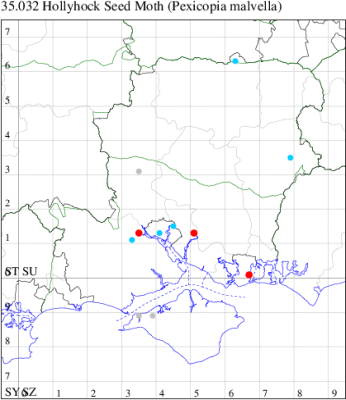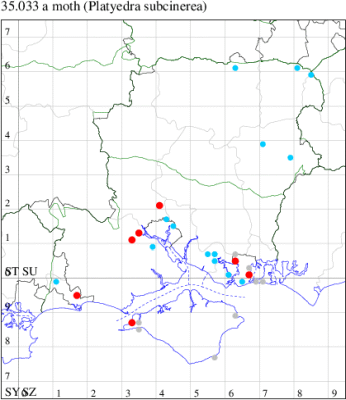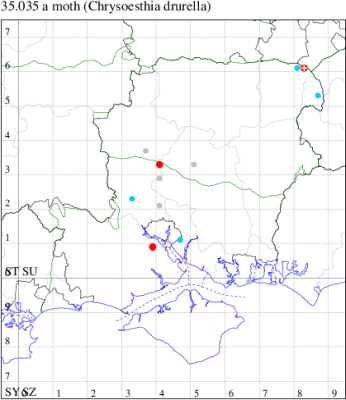2022 Annual Report for: Gelechiidae / Apatetrinae
For species seen in 2022 that had less than or equal to 100 records, full details are included; for more common species, the earliest, latest and highest count by vice-county are shown. The narrative for each species is taken from the main Hantsmoths website, and it is possible that some information on abundance and occurrence can get out of date, as it is impossible to keep up with all changes; however it should give a good introduction to each species. The tables in each species account summarise the previous status, and that for the current year.
For the maps, all records prior to 2022 are shown by a blue dot (the larger the dot, the more recent), with the current year's records shown in red. As previous records are superimposed on any report for 2022, new sites have greater emphasis (i.e. will show as 'more red').
In the species accounts, an asterisk next to a location indicates a new 10km square record; earliest ever dates are highlighted in orange, and latest ever in red. Initials in the species accounts refer to the recorders listed here. Please get in touch if you identify any omissions or errors, in particular if you have records that have yet to be submitted. Details of how to submit records can be found here.
35.032 [B&F: 0809] Hollyhock Seed Moth Pexicopia malvella (Hübner, [1805]) - Nationally Scarce B
Nationally scarce (Nb) in grassland, saltmarshes and gardens in parts of south-eastern England, once widespread throughout England and Wales as far north as the eastern border counties of Scotland, it now appears to be contracting its range (MBGBI Vol 4 part 2). In Hampshire there is a scattering of records mainly in the south-east of the county; in the north, recorded for the first time in 1992, at Leckford, since when only recorded from Selborne and the Bordon area. In recent times, only found on the Isle of Wight at Freshwater in 2010 and 2011, the first record for at least 60 years. Wingspan 18-20 mm. Larva feeds on seeds of Marsh-mallow and Hollyhock, over-wintering in a cocoon.
Records prior to 2022
| Vice County | #Records | #Individuals | First Record | Last Record |
|---|---|---|---|---|
| 10 | 5 | 2 | 1850 | 2011 |
| 11 | 244 | 351 | 1996 | 2021 |
| 12 | 6 | 6 | 2002 | 2010 |
2022 records
| Vice County | #Records | #Individuals | Max Quantity |
|---|---|---|---|
| 11 | 27 | 41 | 4 |

Records by year
Records by week (adult)
Records by week (larval)
Record Details
VC11: Totton, one, 10 Jun; two, 16 Jun; two, 17 Jun; two, 21 Jun; three, 22 Jun; two, 23 Jun; one, 26 Jun; one, 03 Jul; one, 05 Jul; one, 07 Jul; one, 13 Jul; one, 15 Jul; two, 16 Jul; one, 31 Jul (LHan); Botley, one, 28 Jun (SLB); Portsmouth, one, 12 Jun; one, 15 Jun; four, 16 Jun; two, 17 Jun; one, 20 Jun; two, 21 Jun; three, 22 Jun; one, 23 Jun; one, 05 Jul; one, 07 Jul; one, 08 Jul; one, 15 Jul (IRT)
35.033 [B&F: 0808] Platyedra subcinerea (Haworth, 1828) - Nationally Scarce B
Nationally scarce (Nb) in rough ground and gardens in parts of southern England. In Hampshire recorded frequently and in numbers along the south-east coastal strip. Inland, and on the Isle of Wight, there are only scattered records. Wingspan 16-18 mm. The larva feeds on flowers and seeds of Common Mallow and Hollyhock.
Records prior to 2022
| Vice County | #Records | #Individuals | First Record | Last Record |
|---|---|---|---|---|
| 10 | 8 | 5 | 1848 | 2017 |
| 11 | 1062 | 2466 | 1973 | 2021 |
| 12 | 11 | 11 | 2010 | 2021 |
2022 records
| Vice County | #Records | #Individuals | Max Quantity |
|---|---|---|---|
| 10 | 1 | 1 | 1 |
| 11 | 19 | 25 | 3 |

Records by year
Records by week (adult)
Records by week (larval)
Record Details
VC10: Totland, one, 02 Jun (RTer);
VC11: Franchises Wood, NF, one, 18 May (RBW); Totton, one, 02 May; one, 06 May; one, 08 May; one, 27 May; one, 28 May; one, 15 Jun (LHan); Vale Park, Chandler's Ford, one, field observation, 10 May (KArb); Portchester, one, 23 Apr (DH-J det. MJW); Portsmouth, two, 02 May; three, 05 May; three, 06 May; one, 07 May; two, 09 May; one, 18 May; one, 22 Jun; one, 14 Aug (IRT); Burton, nr Christchurch, one, 06 May (JStw)
35.035 [B&F: 0746] Chrysoesthia drurella (Fabricius, 1775) - Local
Local on waste ground, farmland and other open areas throughout much of England, north to Yorkshire, northern Wales, and central Scotland, where it is rare. In Hampshire there are few records of this species, the only recent ones being in the south of the county, at West Park (Rockbourne), Gosport and Fareham; formerly known from Emer Bog and Southsea in the south and Leckford in the north, where the larvae could be found in some quantity. Not recorded from the Isle of Wight to date. Wingspan 8-9 mm. The orange and lead-grey imago is seldom encountered, and the species is more likely to be recorded in the larval stage, when larvae may be obtained by sweeping the foodplant. Larva mines leaves of Goosefoot and Orache, over-wintering in a cocoon.
Records prior to 2022
| Vice County | #Records | #Individuals | First Record | Last Record |
|---|---|---|---|---|
| 10 | 4 | 7 | 1935 | 2014 |
| 11 | 10 | 15 | 1981 | 2020 |
| 12 | 9 | 6 | 1969 | 2020 |
2022 records
| Vice County | #Records | #Individuals | Max Quantity |
|---|---|---|---|
| 11 | 2 | 2 | 1 |
| 12 | 1 | 2 | 2 |

Records by year
Records by week (adult)
Records by week (larval)
Record Details
VC11: Marchwood*, one, nearest area of suitable food-plant habitat not known - maybe Staplewood training ground?, 19 Jul (CTha); Crawley*, one, 30 Jul (GCE);
VC12: Frogmore Community College, Yateley, larva, two, field observation, on Chenopodium alba, 09 May (BGD)